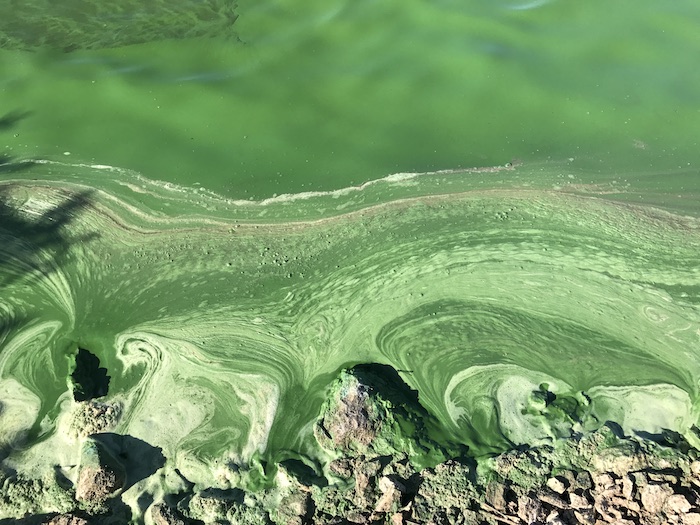Research shows climate change boosts likelihood of toxin releases from algal blooms in American lakes

LAWRENCE — A broad analysis of lake water quality across the United States reveals human-driven climate change is increasing risks of high toxin concentrations from algal blooms in U.S. lakes, posing increasing hazards to people and wild and domestic animals, including dogs.
The investigation, recently published as the cover story in Nature Water, relies on data from lake-water samples from 2,804 U.S. lakes collected between 2007 and 2017 by the Environmental Protection Agency.
The authors, including a researcher at the University of Kansas, use the EPA’s data to predict the likelihood that a toxin called microcystin, produced by some blue-green algal species, will spike above water quality thresholds in the years ahead. Microcystin can damage the liver in humans and can kill wild and domestic animals.
“We found toxic blue-green blooms thrive under climate change conditions and warmer temperatures, particularly in the optimal temperature range of 20 to 25 degrees Celsius, with the highest levels at about 22 degrees Celsius, or 72 degrees Fahrenheit,” said co-author Ted Harris, assistant research professor with the Kansas Biological Survey & Center for Ecological Researchat KU. “It's clear regions with a history of fewer toxic blooms are likely to experience an increase in such occurrences due to climate change. High-nutrient lakes, which serve as a fuel source for these blooms, are particularly vulnerable to this trend.”
Harris’ collaborators were lead author Julian Merder, along with Anna Michalak and Gang Zhao of the Carnegie Institution for Science, as well as Dimitrios Stasinopoulos and Robert Rigby of the University of Greenwich.
Among the team’s other key findings:
- Climate change forecasts show a northward shift in areas that will be at higher risk for algal blooms, particularly the northern Great Plains and northwestern United States.
- Parts of the U.S. with fewer toxic blooms on record are likely to see more of them because of climate change.
- Many agricultural regions with high-nutrient lakes will see more frequent temperatures ideal for algal blooms, with associated risks for drinking water sources, recreational activities and human and animal health.
Harris said public health officials and lake visitors should be mindful of conditions that foster algal blooms — and dog owners in particular should pay attention to the findings.
“The negative effects of these toxins, particularly those affecting the liver, can lead to death, with rare cases of human fatalities,” he said. “However, more commonly, animals, especially dogs, are adversely affected. Blue-green algae differ from other algae as they can float due to small buoyant structures within them. This behavior causes them to be pushed downwind and accumulate near coasts, often where launching ramps are located, and where people take their dogs. This is also where toxin accumulation is more likely.”
As an example, Harris recounted a significant toxic bloom at Milford Reservoir in Kansas in 2011 that led public officials to warn “complaints after recreational exposure include vomiting, diarrhea, skin rashes, eye irritation and respiratory symptoms. These toxins also caused deaths in pets.”
Harris specializes in studying algal blooms, including work monitoring harmful algal bloom distribution, abundance and toxicity. He also works to develop modeling techniques for predicting and forecasting harmful cyanobacterial blooms. He said the statistical findings in the paper lined up with his experiences doing fieldwork.
“On this paper I served as the bloom expert,” he said. “I made sure our results were robust and that we were saying things that we find in general to be true in the field.”
Photo: Blue-green algae scums washing up on shore of Milford Reservior, Kansas, in 2017. Credit: Ted Harris